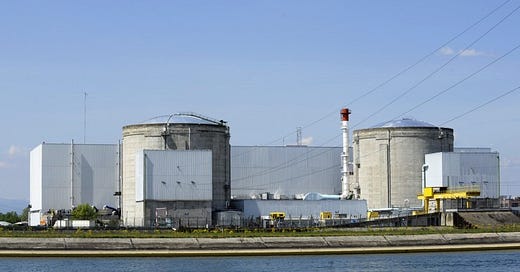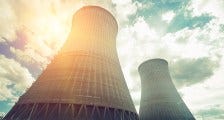That was my suggested headline for my latest piece in Crikey, which ran under the sub-editors (blander IMO) choice of “We don’t need a nuclear renaissance. We need a solid plan on renewables”
The idea of the piece was to respond to Exhibit A in the case for nuclear power, the successful French construction program of the 1970s and 1980s, under the Messmer Plan. I've previously written about the way this program depended on the power of the French state at the time, which can't easily be replicated today. A little while ago, I was suddenly struck by the thought that the Messmer Plan would have been much more effective if it were applied to solar and wind energy rather than nuclear.
We don’t need a nuclear renaissance. We need a solid plan on renewables
The Peter Dutton-inspired waffle about replacing coal-fired power with nuclear energy deflects serious conversations about decarbonisation.
Energy Minister Chris Bowen’s estimate that it would cost $387 billion to replace existing coal-fired power stations with small modular reactors (SMRs) is unlikely to quieten the advocates of “having a debate” over nuclear.
Indeed The Australian’s editorialist fired straight back, comparing this estimate with a suggested cost of $1.5 trillion to decarbonise the economy by 2050. The fact that the second estimate includes replacement, not just of coal-fired power stations but of all uses of gas and oil (electricity, transport, heating and industry), seems to have escaped the writer.
Nuclear industry has gone nowhere in the past 20 years, with old plants closing as fast as new ones opened. But nuclear advocates’ hopes remain undimmed. Central to their faith is the example of the French nuclear build in the 1970s and ’80s. From a standing start, France built 56 power stations in 15 years, most of which still operate today.
But nuclear advocates have drawn the wrong lesson from the French experience. The crucial factor was not the merits of nuclear technology, but the strength of the French state and the determination of Prime Minister Pierre Messmer, embodied in the “Messmer plan”.
What we need today is not a nuclear renaissance but an Australian Messmer plan for solar photovoltaic (PV) and wind.
The Messmer plan had its origins in the immediate aftermath of the OPEC oil shock of October 1973. Less than six months later, on March 6, 1974, Messmer announced that France would go “all electric, all nuclear” to free itself from dependence on fuel imports.
The speed with which the plan was implemented seems unbelievable now. There was no debate in Parliament and scientific critics were brushed aside. By November 1974, the first concrete was being poured at three power stations. There was no time for environmental impact statements, community consultation or economic analysis. The project was undertaken entirely within the public sector, with access to low-cost finance and unpriced resources.
The Messmer plan eventually ran out of steam. Escalating costs of power plant construction and a decline in the price of oil meant that the “all electric” part of the plan never happened. But at least in electricity, France remains a standout case of a rapid energy transition driven by government action.
The critical point is that the success of the Messmer plan didn’t depend in any way on the fact that the chosen technology was nuclear power. Even with the power of the French state to override obstacles, nuclear plants still took an average of six years to build. By contrast, once the lengthy permitting phase is over, a wind turbine project can be completed in six or seven months. Under favourable conditions, solar PV can be installed even faster.
Disarming the persistent myths of a glowing nuclear renaissance
An Australian Messmer plan would override all the obstacles that prevent a rapid transition to carbon-free energy. The complexities of the national electricity market and its pricing schemes would be swept away. Nimby objections to the appearance of wind turbines and claims about undetectable health effects would be ignored. Transmission lines would be built where and when they were needed, with no need to consult landowners.
The original Messmer plan failed to electrify transport, but that would be much easier today. Importing internal combustion engine (ICE) vehicles would be banned, and existing vehicles would be subjected to increasingly stringent requirements. Industry would similarly be pushed to electrify as fast as possible.
Obviously nothing like this is going to happen in the Australia of 2023. We have environmental impact assessments and community consultation for good reasons, and that isn’t going to change. Concerns about public debt still limit the scope of public investment. And since the departure of Kevin Rudd (whose announcement of the NBN was almost as abrupt as that of the Messmer plan), there is no-one on the national political scene with anything like the drive of Messmer.
Still, it is important to understand that all these processes come at a cost. Every day the world delays decarbonisation, the climate gets hotter and resulting catastrophes get worse. When the now-inevitable catastrophes of flood and fire return this summer or next, we should consider whether the France of the 1970s has something to teach us about energy transitions.





https://news.ontario.ca/en/release/1002543/ontario-breaks-ground-on-world-leading-small-modular-reactor
Unless the tradies are working for nothing Canada is spending money
'we'll need either some longer term storage options'
Since your linked post on baseload power is from 14 years ago, & such an option has not been developed in the interim I'll call this handwaving
Agreed on gas peaking plants, rather than coal.